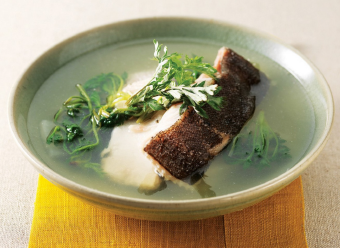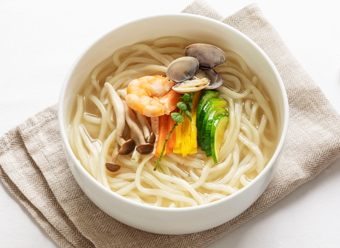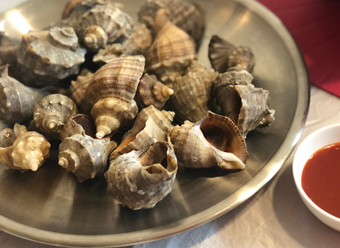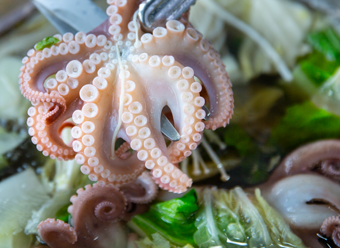한식 읽기 좋은 날
Vol 50. Korean Food, The Culture Blooms
Seasonal Ingredients from the Sea That Cannot be Missed at This Time
The most delicious food right now is a table set with the ingredients grown during this season. Even if you don't have any cooking skills, the rich aroma and flavor are enhanced by ingredients that are in season.
If you use seasonal seafood that should not be missed at this time of the year when spring comes to a head, you can bring the energy of the overflowing sea onto your table.
Reference. The Digital Local Culture Encyclopedia of Korea, the Encyclopedia of Korean Culture, Doosan Encyclopedia, KISTI’s The Scent of Science

Flounder, the Messenger of Spring with Superb Light Flavor
There is a saying, “Spring flounder, autumn gizzard.” For flounder, the winter is the spawning season, so if you eat it at this time, the meat is weak and the quantity is small, but in April, when the spawning season ends and the flounder’s flesh starts to fill up, its flavor and nutrition improves, so the price is the most expensive at this time of the year. Dodarissukguk(flounder and mugwort soup), made with fragrant mugwort sprouting in the spring, is considered a representative health food that you must try in the spring because you can take the rich protein of flounder and the nutrition of mugwort, called a “multivitamin.” Flounder is one of the most caught fish in the Masan region of Gyeongsangnam-do. It is often called dodari, but its correct name is munchigajami(marbled flounder or marbled sole), and belongs to a family of flounders. It is similar in appearance to olive flounder, so if it has a large mouth and teeth, it is classified as an olive flounder. If it has a small mouth and no teeth, it is classified as a marbled flounder. Flounder is good to enjoy as sliced raw dish at this time of the year, and it is refreshing and clean, so it is often eaten in a soup dish. Moreover, it is used in various dishes such as maeuntang(spicy stew), jorim(braised dish), gui(grilled dish), twigim(deep-fried dish), etc., all boasting of its light flavor. Flounders live at the bottom of the sea, and take three years to grow so they are not farmed. The ones without red sheen on its belly are the good ones.

Bajirak Boasting of Rich Flavors of the Sea and the Most Refreshing Taste Among Shellfish
Bajirak(clam) is distributed in almost all the coasts of Korea, and especially in Seohae(the Western Sea). It lives mainly in tidal flats or shallow seas, and because they don’t move so much, farming has been developed since the ancient times. It has the most refreshing and richest flavor among shellfish, and is often used to make broth for kalguksu(noodle soup) or jjigae(stew). It has a refreshing flavor that makes it a good ingredient for doenjangjjigae(soybean paste stew), and it is nutritionally balanced since the soybean paste supplements the lack of vegetable protein in the clam. It is good as a diet meal because of its low calorie and fat content. Also, it contains iron, making it effective in preventing anemia. Among the dishes that use clam as an ingredient, the first thing that comes to mind is bajirakkalguksu(noodle soup with clams). It is a local dish of the Jeonnam, Jeonguk, Chungnam, and Ansan regions that are adjacent to the tidal flats. Its unique seafood flavor of the broth blends well with the noodle soup, thus gaining popularity. You can easily encounter bajirakkalguksu in the downtown areas in addition to the areas near Seohae(the Western Sea).
Clams are in season from February to April. They contain plenty of taurine, which helps in the liver function by discharging cholesterol from the blood, thus improving blood circulation and promoting bile secretion. Moreover, since the ancient times, it has been known as a good food for improving liver function and relieving hangover. Also, it is rich in methionine, which helps in protein synthesis, zinc, which prevents taste disorders, and calcium, which is good for bone health.

Sora Raising Appetite with Its Chewiness
Sora(top shell) with hard meat is a popular food in the spring, especially as a pairing for liquor because of its chewiness. It is difficult to separate the skin from the flesh while it is alive, so you can separate it cleanly by steaming it lightly, and then pulling it out with chopsticks. Though there are hardly any dishes made with top shells in Korea’s old cookbooks, but, in <Sallim Gyeongje>, a Korean book on living and farming written in the Joseon Dynasty, states, “It is almost identical to raw abalone if you separate the flesh of the top shell and cook it, and it also tastes good.” There is also a record of serving soracho(top shell salad) in a royal feast. Top shells are in season from March to June, when the spring comes to an end, and while it is served steamed, seasoned, or grilled, the easiest and tastiest way to eat it is boiling it and dipping it in chogochujang(sweet and sour red chili paste). When you eat it with dubu(bean curd), you can supplement the protein lacking in the top shell, and take in minerals, such as zinc and folic acid, which are lacking in bean curd at the same time. The top shell is rich in vitamins and minerals because it eats sea plants, such as seaweed and kelp. It contains essential amino acids such as arginine, lysine, and histidine, which help muscle production and growth development, and these ingredients are also good for preventing various cardiovascular diseases and arteriosclerosis. Moreover, the top shell contains collagen and vitamin E that are effective for skin care and anti-aging, as well as vitamins B₁·B₂ that are good for preventing anemia, and vitamin A, which is good for eye health. Thus, it is a good ingredient for all ages.

Jukkumi, Good for Relieving Fatigue with the Taste that Awakens Drowsiness
Jukkumi(webfoot octopus) is a must-eat seafood in the spring, as it is so popular that many webfoot octopus festivals are held every spring. This is an octopod that is distributed all over the coast of Korea, and is commonly found in rock crevices in shallow waters. It resembles nakji(long-legged octopus), but is smaller in size. The method of catching webfoot octopus is also interesting. They are caught with nets, but they are also caught by using the empty shells of the top shell and gastropod. If you tie a few shells of the top shell, gastropod, or abalone to a string, and sink them to the bottom of the sea, the webfoot octopus, which is active at night, enters the shells. In the past, during the barley hump, webfoot octopus served as an emergency food for people along the coast, and, afterward, people who knew its taste mainly in the south or west coasts enjoyed eating it, instead of long-legged octopus. The charm of the webfoot octopus, which is softer than long-legged octopus and more savory than squid, must have gotten good word of mouth as it is sometimes said, “Spring webfoot octopus, autumn long-legged octopus.” The spawning season is from May to June, so it is most delicious during the period from mid-March to May when it is packed with eggs. For webfoot octopus, a stir-fried dish with gochujang(red chili paste) seasoning is a common recipe to enjoy its unique savory taste, and yeongpotang(octopus soup) boiled lightly is also a dish that can be enjoyed for its refreshing flavor. Cooking it too long can make it tough, so it is best to keep the cooking time as short as possible. Webfoot octopus is delicious, but, recently, it has been attracting attention as a health food because of taurine. According to the National Institute of Fisheries Science’s “Korean Seafood Composition Table,” taurine in webfoot octopus is twice that of long-legged octopus, four times that of octopus, and five times that of squid. Taurine is known to lower cholesterol, and is effective in relieving fatigue. In the spring when you feel drowsy, it would be good to shake off spring fatigue with delicious webfoot octopus dishes.


 한국어
한국어
 English
English






